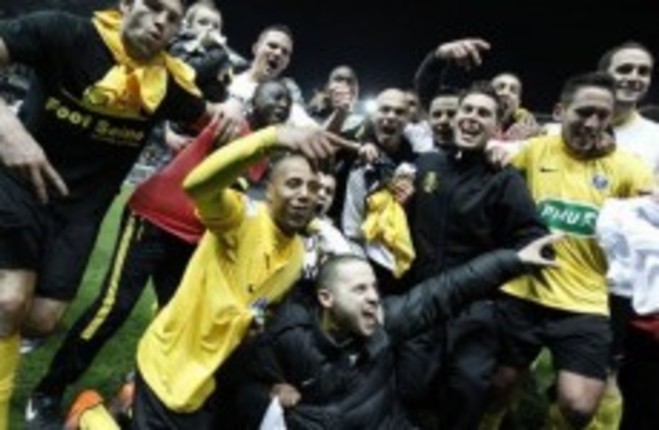EVERY COUNTRY HAS a club that proclaims themselves to be “the cup specialists”. Despite what the Ligue 1 big boys might say, in France, that tag properly belongs to the amateurs of Union Sportive Quevillaise (US Quevilly).
This evening in the Stade de France, the third division strugglers from Normandy will go toe-to-toe with Olympique Lyonnais in the final of the premier cup competition, the Coupe de France.
Without further decoration, that simple fact is impressive enough, even more so when you consider that 7,422 teams entered this year’s tournament, conjuring up fairytale fixtures between the likes of Red Star Paris and Tahiti in the early rounds. (By comparison, 763 teams entered this year’s FA Cup.)
There’s a lot of chaff to be winnowed, but by the time you get down to the business end, there’s nowhere to hide. On the road to Paris, Quevilly accounted for two Ligue 1 teams — Marseille and Rennes — proving their stripes and playing their way to international attention.
The run may seem like another flash in the pan giantkilling to casual observers, but to those in the know, it comes as no surprise. Since they were founded in 1902, the northerners have toppled no fewer than 10 Ligue 1 sides and few would bet against them adding another scalp this afternoon.
“I think there’s an illusion that down in the third, fourth, fifth divisions it’s awful, but it’s really not,” Andrew Gibney of French Football Weekly explains. “You get a lot of the kids that get dropped out of the professional teams when they’re kids, and they’re decent players.
Because French football is regionalised, you’ll get kids who play for Caen and drop out, and they’ll go to the likes of Quevilly. They’ve obviously been at a professional level at some point, good enough to play for these teams as kids. They drop down and they just make a living playing there.
And so Quevilly have picked up the likes of Zanké Diarra, a 26-year-old midfielder who had the privilege of dumping his internationally-capped brother, Alou, out of the tournament when they beat Marseille 3-2 after extra time in the quarter-finals. Striker John-Christophe Ayina learned his trade at Paris Saint-Germain.
For these players, the professional dream has died. Quevilly’s annual budget stands at €1.9m, about 1% of the €130m warchest which Lyon have by comparison. The bulk of the squad are paid, with 14 on full-time contracts, but even the top earners pocket a maximum of €3,000 a week.
But though the money might not be the same, for some, the ideal of honour and glory never dies. Quevilly were cup finalists once before, all the way back in 1927, and semi-finalists under current manager Regis Brouard in 2010. Their knack for clicking in the cup has tempted some new recruits to the club, Gibney explains.
Players have been joining them to go on a cup run because they have this cup run history. They made it to the semi-finals two years ago, they’ve been to the final before in 1927. They’re a real cup team so players join them because they think they can go on this amazing cup run. It’s in their history, and for a team that’s played most of their football in the fourth division, it’s incredible.
Quevilly’s own pedigree is only part of the reason for their success, reflected throughout more of France’s amateur sides. This year’s other semi-finalists, Ajaccio, are also in the third division while fifth-tier Chambéry made it to the quarter-finals last season.
Part of the reason lies in a format quirk whereby a team drawn against an opponent two divisions above them are automatically given home advantage for the tie.
“In the early rounds, they’re playing in these little 2,000-capacity stadiums,” Gibney continues. “The conditions are never good because it’s normally in January or February, so if the big teams aren’t up for it, they’ll get turned over. It happens more often than you’d think.
“The big teams do go out to win it, but in January and February, they’re just back from the winter break and the cup is the first thing they have to play in. I think they find it difficult to get up for it, but you regularly find the bigger teams getting through to the semi-finals.”
Even when teams like Marseille and Rennes make it to the knockout stages and set their sights on winning a domestic trophy, these amateurs are no pushovers.
In the Marseille game where they won 3-2, they played much better football than Marseille. They were tactically sound. There were no fitness issues that you sometimes find; I think that was Marseille’s game plan, to tire them out and it didn’t happen. Against Rennes, they scored an injury-time winner. These guys, their fitness is one of their key strengths, they’re not going to tire.You can see that they’re not hit-and-hope, they’re not plucky underdogs built on spirit. They’ve got technique and quality.
Quevilly’s is a true underdog story, one which is not necessarily destined to end in heroic failure either. But the hard-headed realities of UEFA coefficients and lucrative European spots means that not everybody in France will be cheering on the men in yellow and black on Sunday. A Lyon victory would suit many, sad as that may seem.
“From a Europa League point of view, France can’t really win in this cup final. If Lyon go on and win, everyone will just say that Lyon were the much better team but if Quevilly win, they’ve then got a team from the third division in the Europa League with the coefficient tumbling as it is.
“In a way, they’d rather have a team from Ligue 1 in Europe flying the flag. It’s a shame that teams haven’t tried in Europe over the years and now they need to coefficient points to keep them up there.”
For the football romantics though, there will only be one cry worth roaring: Allez Quevilly!

